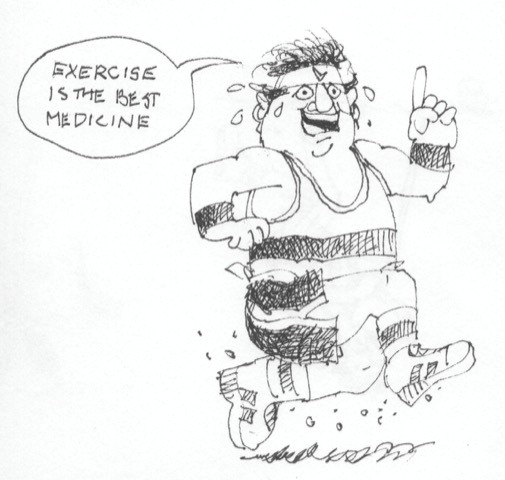RUNNING, DISEASE AND MORTALITY
I try to be a bit topical in these blogs, writing about recent publications, studies and reports on exercise related subjects. I aim not to give recommendations for particular types of exercise or physical activity but today my latter aim is in conflict with the former. A study was published last week in the British Journal of Sports Medicine about the beneficial effects of running. I must start by declaring an interest. I am a runner, albeit rather aged and slow.
The benefits of running
The authors have performed a meta-analysis (a summation of the results from a number of different studies – see glossary) of all the available studies of runners which included long term outcomes. They identified 14 studies with 232,149 participants. 25 951 deaths were recorded during follow-up periods of 5.5–35 years. The findings were that, compared to non-runners, running participation is associated with 27% lower risk of death from any cause during the period of follow up. There is also a 30% reduction in death from heart related disease and a 23% reduction in death from cancer. Note that the definition of a runner in this study was someone who was a runner at the point of entry into the study. Whether or not the subjects continued to run over the period of follow-up was not a factor.
These findings are not entirely surprising and probably underestimate the benefits of continued participation in running. Exercise is known to protect against heart disease and also reduces the risk of a number of different types of cancer including colon, breast, uterus, gullet, gall bladder, pancreas and kidney. Physical activity is known to increase life expectancy, mainly through reduction in heart disease and cancer. A previous review of all the available evidence indicates that runners have a 30-45% reduced risk of premature mortality and live approximately 3 years longer than non-runners. Increasing the time spent running and increasing the intensity are both related to benefit up to about 4 hours per week.
How much running is needed?
Surprisingly little according to the results of this meta-analysis which has confirmed that a little exercise is very much better than none. The response to exercise for most outcomes in “non-linear”. That is to say the benefit versus exercise dose curve is initially steep and then climbs more slowly. Some studies have suggested that with increasing levels of exercise the benefits fall off and even start to reduce. Others have found that there is no limit to the increasing benefits from increasing exercise. I tend to believe this version!
Running as exercise
I have declared my interest. There about 5 million regular runners in the UK so its popularity is not in doubt. There are good “entry points” to the sport. Many children now run the daily mile at school. The Couch to 5K app has stimulated a great growth and Park Runs (parkrun) are attracting ever increasing numbers.
Just in case you are not aware of parkrun, it is a series of free, weekly 5k events for all ages held every Saturday morning at 9am. Currently there are 680 events in the UK and parkruns are held in another 20 countries. More than two million individuals have signed up to take part. It is fine to walk or to walk/jog. Some general practitioners have joined a “parkrun practice” initiative, linking in with their local event(s). It a feature of these practices that the staff, including the doctors, are encouraged to take part, thus fulfilling the subject of my last blog, to set a good example.
Running is cheap (well once you have bought a decent pair of trainers), quick to do, requires no skill and does not need either a team or an opponent. So, time to get off the couch, reduce your chance of a host of degenerative diseases and increase your lifespan and healthspan?
- http://dx.doi.org/10.1136/bjsports-2018-100493
Subscribe to the blog
Categories
- Accelerometer
- Alzheimer's disease
- Blood pressure
- BMI
- Cancer
- Complications
- Coronary disease
- Cycling
- Dementia
- Diabetes
- Events
- Evidence
- Exercise promotion
- Frailty
- Healthspan
- Hearty News
- Hypertension
- Ill effects
- Infections
- Lifespan
- Lipids
- Lung disease
- Mental health
- Mental health
- Muscles
- Obesity
- Osteoporosis
- Oxygen uptake
- Parkinson's Disease
- Physical activity
- Physical fitness
- Pregnancy
- Running
- Sedentary behaviour
- Strength training
- Stroke
- Uncategorized
- Walking



Hi,
I suffer from atrial fibilation and my heart rate can vary between 78bpm to 130 bpm. Will even moderate speed running be detrimental or good for my health
Thank you for your query – and sincere apologies for taking so long to reply.
Atrial fibrillation (AF) is no bar to exercising and people in AF gain the same benefits from exercise as anyone else – maybe more! Provided you have no other condition which would make exercise a problem (some heart valve diseases, uncontrolled heart failure, illness with fever) you can do what you want. My advice would be exercise for three to five times weekly to the degree which makes you short breathe but not uncomfortably so. You will not be able to use your heart rate to judge how hard to exercise. I will be discussing this in a future blog
Hugh